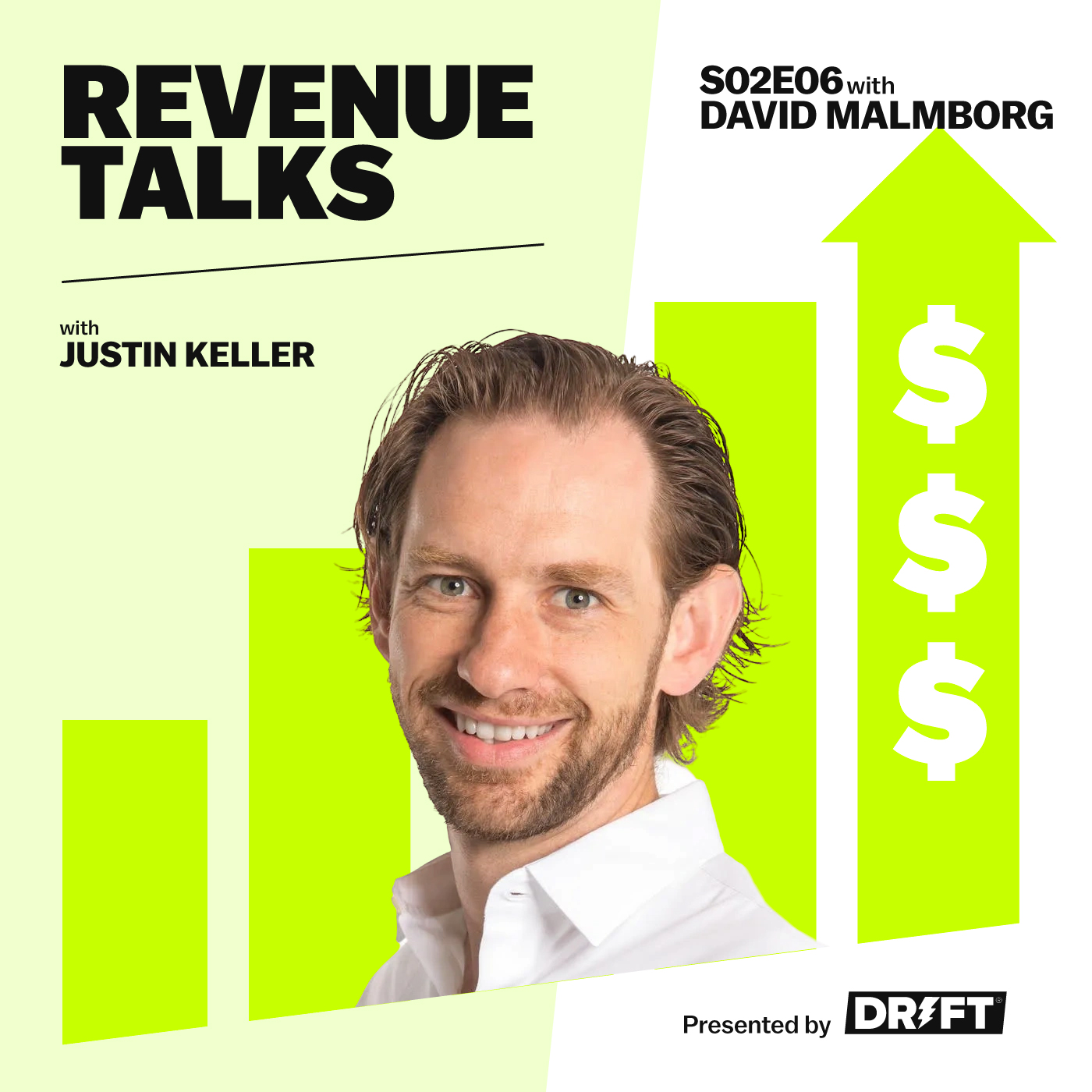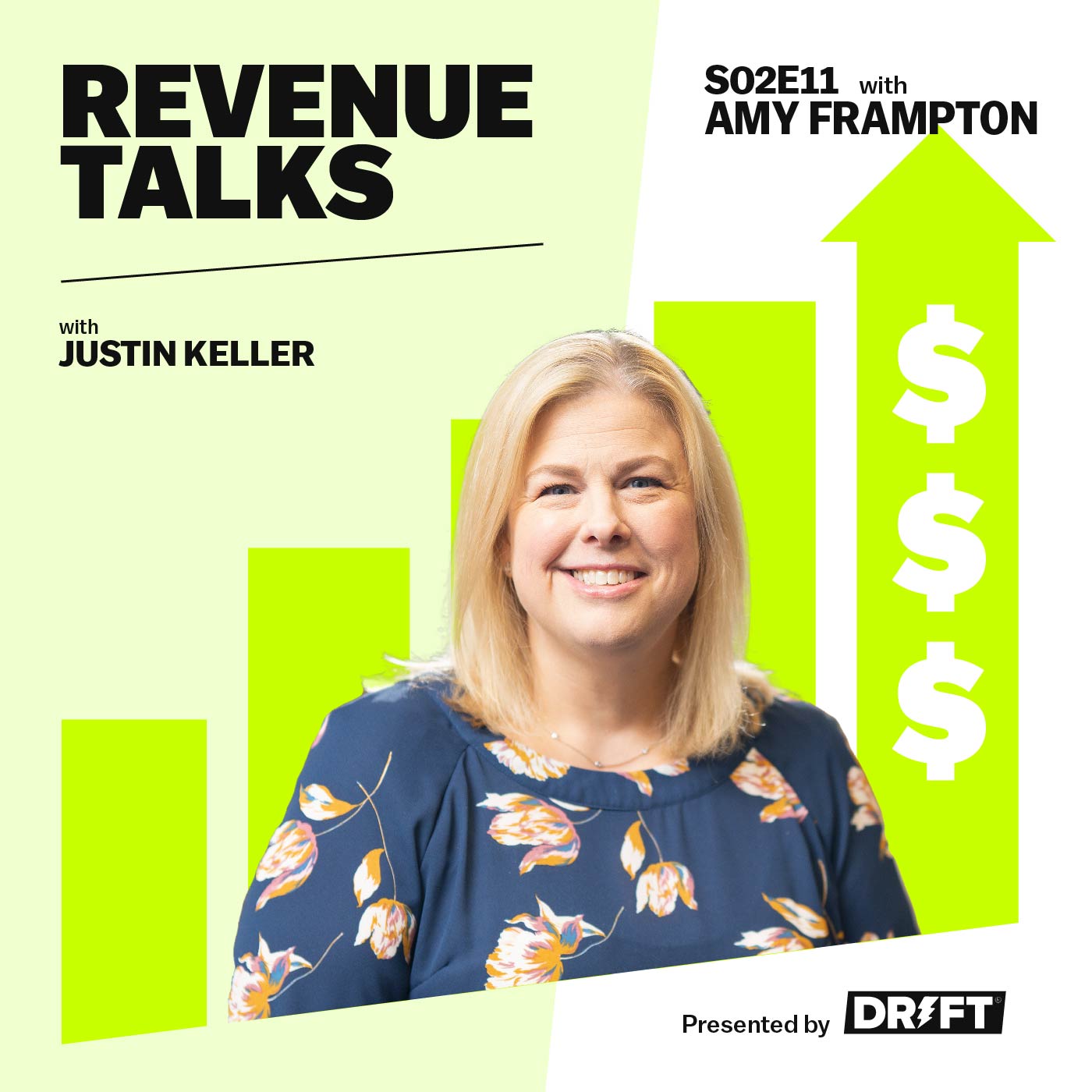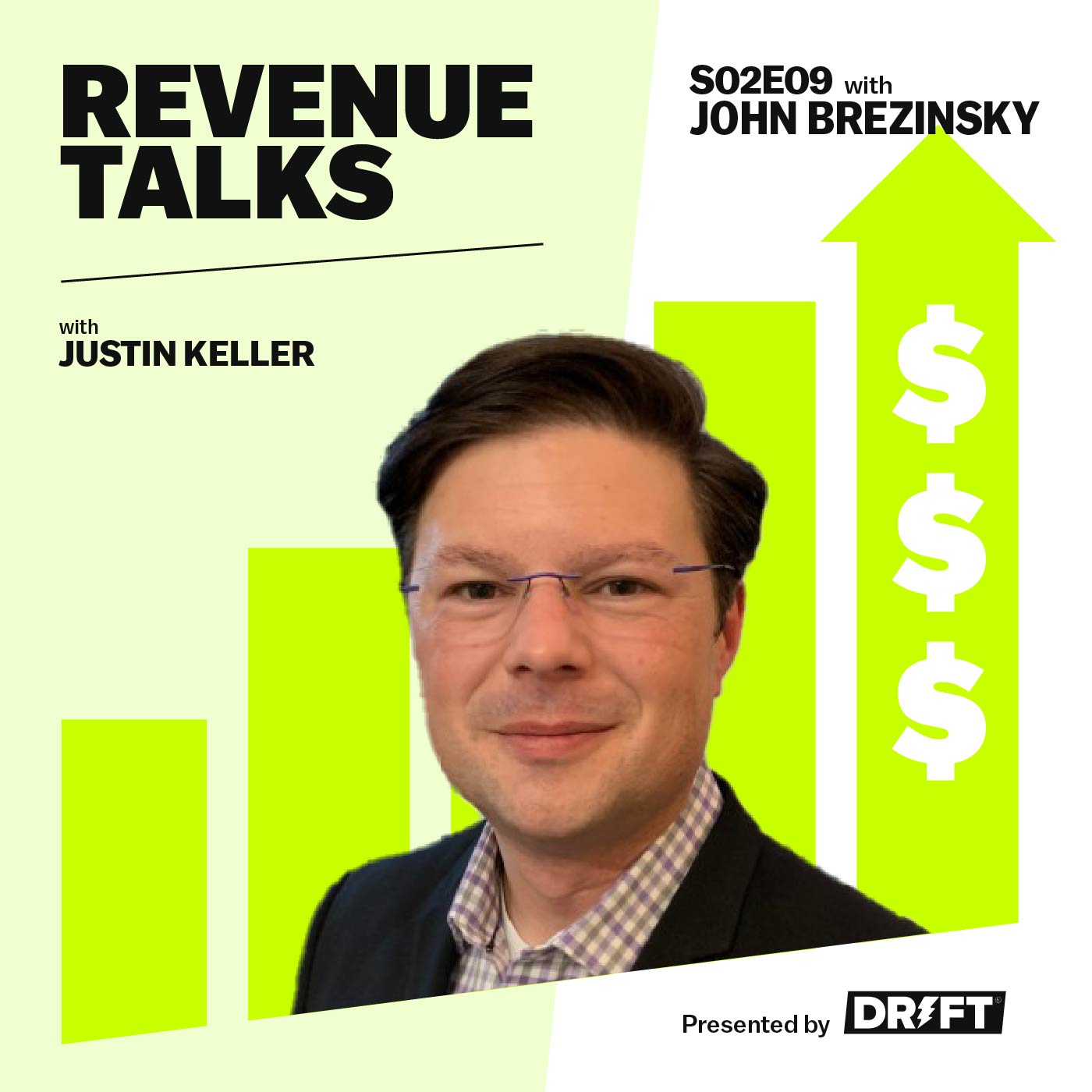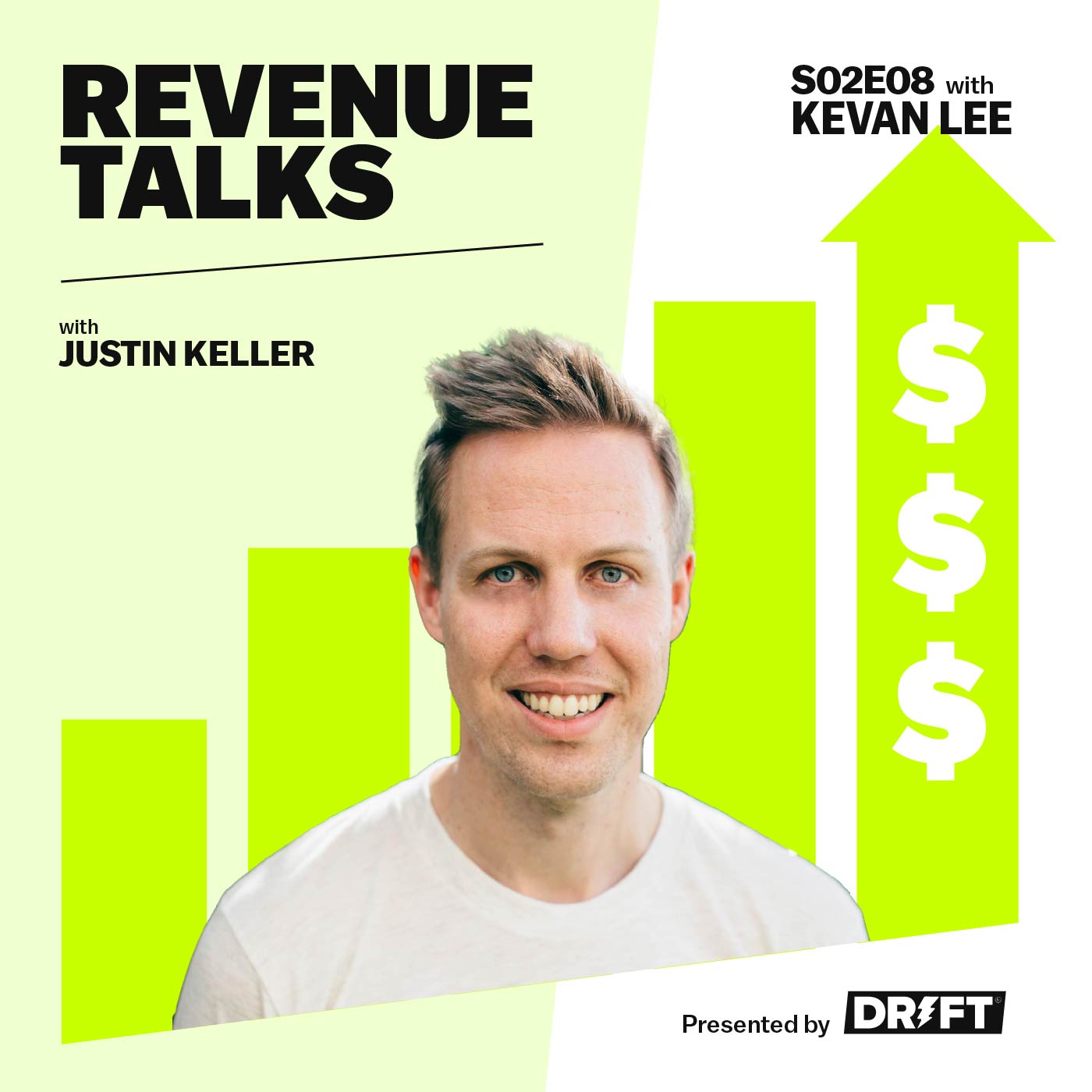The Macro & Micro Levels of Communication | David Malmborg
- 0.5
- 1
- 1.25
- 1.5
- 1.75
- 2
Justin Keller: Welcome to Revenue Talks, the show where we get real about what it takes to build pipeline and drive expansion as a go- to- market team. I'm Justin Keller, the vice president of revenue marketing at Drift, and on this show, I'm here talking to folks across the entire go- to- market organization, which means marketing, sales, and customer success, about how these conversations, technology, and cross- functional alignment to build more pipeline and drive expansion because revenue is everyone's business now. Hello. Welcome back to Revenue Talks. I'm Justin, and today I could not be more stoked than to have David Malmborg joining me. David is the vice president of marketing at Nivati, which is a company focused on employee mental health and wellbeing, which is something I'm actually really enthusiastic about myself, having spent some time at an employee wellbeing company myself, so excited to click in on that. David also made our top marketers to watch list, this year, so if you haven't checked that out in the blog-
David Malmborg: Thank you.
Justin Keller: ...make sure you do. So, thank you. Congrats. And for those listening, link is in the show notes, down there below... Depending on where you're listening to this, it's somewhere around this podcast. So, today, I want to talk to David about a particularly big and nebulous topic, which is brand affinity. And I think outsiders think of brand affinity as a marketing responsibility, but I think if you're listening to this podcast, you're in the know, and you know it's way bigger than that. Brand affinity is an entire company thing, so listen in as we chat about how he manages cross- functional relationships to create a consistent customer experience that people love and make love the brand. So, let's get into it. David, thank you so much for coming on the show.
David Malmborg: It's a pleasure. I'm excited to be here, honored to be on the list you guys have for this year, and yeah, really excited to talk to you. It's going to be a great conversation.
Justin Keller: Let's get into it. I can't wait either. So, let's start with the biggie, brand affinity, which is obviously important to a lot of companies, right? But I imagine that this is probably particularly important to Nivati because Nivati, being an employee wellness app, you likely sell into HR, employee engagement, some department, but that's not the end experience, right?
David Malmborg: Yeah.
Justin Keller: Your products are ultimately experienced by every employee, right?
David Malmborg: We live with the concept that every employee's a marketer and that we try to make it that way, where we have every employee feel comfortable in understanding what it is we're doing, why it's important, and then we try to stay pretty in sync with what everybody's doing and what those touch points actually look like. And this concept of brand affinity really originated... I got, I'd say, a really close education on it from the previous company I was at. I was running a marketing agency. I was with a marketing agency called Struck, and they really hang on this concept of what brand affinity is. And I had the task, when we were really trying to figure out how do you define brand affinity? How do you quantify brand affinity? There's four, primary components that we went down, to try to label and understand what brand affinity actually was, and we tried to figure out a way to quantify what that was. But one of the first and primary themes that's essential for there to be actually brand affinity for any company, for that matter, is really having a purpose behind that brand. And I think we're blessed, in the fact that mental health is really one of those topics that a lot of people can get behind, but it gives us an opportunity to really drive our purpose. And that's such an important part in what we do and an important part in how we focus our marketing efforts too.
Justin Keller: Yeah, I think that is... I don't know if I would call it a luxury, but it's definitely helpful to you, to have a mission- driven company. You're trying to do something good in the world, which makes it easy for people to line up against it. So many B2B marketers don't have that luxury and have to try and convince the world to fall in love with their widget that makes efficiency 10% better, and it's a good thing. And no shade, but they don't get the luxury. They don't have the ability to really drive that brand affinity the way, but I think it's, that said, not impossible, right? You can make people fall in love with a brand.
David Malmborg: For sure. Yeah, and that's where some of the other elements really come into play. So, going back to what we created at Struck, the four, primary components of brand affinity was having a purpose. We're lucky it's a mental health app. I guess maybe I could back up. Nivati is a mental health app, a mental health benefit for employers, and we provide a variety of different tools for actively help and support employees and their mental health needs. And so, we have a purpose, where we have a very mission- oriented goal, when it comes to our marketing efforts, but the other components really can drive brand affinity equally. And that's what we call design performance, and what that means is actually having the component, the product, the experience designed well from top to bottom. Every interaction has got a design component behind it. Having an audience experience, one of my favorite aspects of marketing, and I've never actually worked for a consumer company. This is the weird part behind it, but my favorite component of marketing is actually the unboxing event. What does that event actually look like when somebody first touches your product? And I think that can be such a powerful marketing experience, and so that audience experience is really good. And then a key to any other marketing or really touchpoint that you have with a customer, is making sure that you have the opportunity to get proper feedback from that customer and making sure you understand what the voice and the perception of that experience is, with the customer. So that's where survey data and whatnot can be really valuable. So, maybe purpose might be a little bit tougher for what you're doing, but I don't even think that's impossible. You look at some of these brands that people really love. Patagonia, for better or worse, they've really driven a purpose around nature or whatever that may be because of their outdoor gear. And every company can find what that purpose is, but if purpose is maybe the weakest part to your brand affinity experience, there is a lot you can do around the design and the experience and making sure you're collecting that customer feedback.
Justin Keller: I think that's right on, and I totally agree that. Unboxing experience is amazing, and I think it's something that, I don't know, maybe marketers aren't thinking enough about because you can approximate or find an analog for a lot of B2C experiences in B2B. And I think, for you guys, it's probably when you roll it out to the employee group that's going to be getting this benefit. But how much of that is marketing driven? How much of that's product driven? I presume the answer is both, but if that's true, how do you get those things to line up?
David Malmborg: Yeah. Yeah, so that's where it's really important that you have great communication across the board. So, I have very consistent and deliberate sync up meetings with our product team, our customer support team, our sales team, and really making sure that I have an understanding of what they're doing, and even our provider team, so our provider of experts or our network of providers such as counselors and nutritionists and yoga instructors and all of that. The director of our clinical operations, I'm in touch with her, quite a bit, as far as understanding what I'm saying. Does that resonate well? Do the providers respond well? Would they understand if I started saying things this way? And I make sure I have very clear language in what we're saying, from a marketing perspective, and then I make sure that that language translates very well to what the product experience actually is. And in fact, our product director and myself, we've been going back and forth, quite a bit, as we are reworking, just at a fundamental level, how we talk about what our product is and the benefits that come about it and why it's important and making sure that it's all clinically backed by what the experts are actually saying.
Justin Keller: Got you. Yeah, we'll talk about sales and marketing work together, in a minute, but I think that the marketing, especially when your product, I think, probably scales with the number of people that your product touches, marketing and product being in lockstep is so critical to that brand affinity and making sure that it feels like a cohesive experience.
David Malmborg: Yeah.
Justin Keller: If they're completely disjointed, it's almost like you're being lied to.
David Malmborg: Yeah. For sure. That's really important is what I want, as the head of marketing, is I want the first touch experience that they have, whether it's at a conference or the website or maybe some event where we spoke at, whatever that first touch experience was, they should be able to recognize that that's the same company when they sign up into our app and actually start using the app. And it's like, yeah, same company that I started here is the same company I'm working with here. And it sounds weird. That sounds such an obvious thing to say and want, but the reality is, is a lot of people don't actually have that experience, from end to end, with a lot of products.
Justin Keller: I think that shows up particularly viciously when you've got a very pressured, managing marketer, whose job is to just get people into the app or get people to fill out the form and completely detaches themselves from the product experience. And I feel like that's where you get these over- hyped marketers that you can tell this is not an authentic marketing experience, and I think that's what we're getting at, right? I think where we're circling is that genuine brand experience is the thing that creates the affinity.
David Malmborg: Yeah. Yeah. And that experience, from top to bottom, is what creates that affinity, and it's important. And it's totally understandable when you get a marketer who's maybe siloed, or they have one goal, and that goal is to make sure their Google Ads campaigns is running as efficiently as possible. And you want those people who have those very deep, in depth knowledge and experience on whatever channel or technology that they're asked to deploy and manage over, and that's really good. At the executive level within the marketing department, though, you got to make sure that that orchestration is there, that they understand that that person has to take ownership of what it is that we talk about, how we talk about, and what those touch points look like and make sure that that's well understood to the individual who's neck deep in Google Ads work.
Justin Keller: Yeah. Yeah, I totally agree. And if you can make that great experience, then ideally, that becomes revenue, right?
David Malmborg: Yep. Yeah.
Justin Keller: And so, let's maybe take the conversation there, is talking about our relationship with our friends over in sales, who we love because they're listening to this conversation too, David, FYI. And acknowledging that there's one or two sales people listening to this, you said on another podcast that marketing is an asset to sales. And before our sales friends get too wound around the axle on that, I think you came from a good place, in saying that, at the end of the day, marketing is in service of building a pipeline and revenue, which is a way of saying, " Hey, we're here to help you, the sales team," right?
David Malmborg: Yeah. Yeah. So, I don't think this is a unique opinion, but the way I look at marketing, I look at marketing as a sales team, right? We're a macro sales team, versus a micro sales team, and that's really what the difference is between marketing and sales, is the macro level of communication, versus the micro level of communication. When that is done right, though, and you're looking at that, again, just going to the alignment of what's being said at the macro level matches what's being said at the micro level with the actual sales team. I do consider, especially right now, we're a pretty young company, and revenue's incredibly important to us. And so, we need to make sure that we are getting sales and people on board with our company and enjoying the product that they're having with us. But I look at us as being a necessary service department for sales, especially at this level. I want to make it as easy as possible for the sales team to accomplish their goals, whatever the case may be. So, the sales team will come to me and say, " Hey, I really need a calculator, so people can understand what the ROI is when they sign up for our product." And so, my number one goal, at that point, is, hey, is that going to make your conversations a lot easier? Then the number one thing I'm doing, right now, is making you an ROI calculator. Come to find out three, four weeks later, I build an ROI calculator, and it's not necessarily sending the message that they were expecting it to send, for one reason or another. They don't believe it. The source of data's not quite there. The calculation might be off. Whatever the case may be, is I'm there to fix it and make sure that that works for them. We're going to go to a conference, next week, and I need to make sure that the sales team has the assets that they need so that they can have a conversation. Whether it's in a PowerPoint format that they can pull up on their iPad, whether it's actually printed assets, whatever the case may be, my goal is to make sure that whatever conversation that they're actually having at the event is as easy as possible and their ability, and this is what's really important, their ability to have the follow- up conversations, book the demos, schedule the appointments, whatever the case may be, is also simple from a technology standpoint. So, it's seamless, where... Sales people don't want to work too much to get the sale, and I don't mean that in a derogatory way. They don't want to get bogged down in learning the technology. They don't want to get bogged down in trying to figure out what the right steps are. So, my goal is to make sure that that job is as easy as possible so that they can spend more time talking to people, right?
Justin Keller: Fair. Fair. And I largely agree with that, but I want to... And maybe this is a little bit provocative. Is there for you, in your opinion, is there a line, right? I agree that I, as a marketer, am a steward of pipeline. I'm at the service of my sales leaders. I want them to bring in revenue because, ultimately, that helps me. But at some point, and people listening to this conversation certainly have had this experience. At some point, there's going to be a time where marketing feels like it knows better than the salesperson, right? Would you agree with that? Is that always the case? And if so-
David Malmborg: Yeah. Yeah. Sorry. Go ahead, finish. I-
Justin Keller: No, what should we be looking at, as marketers? Because I agree, maybe it's nine times out of 10, maybe it's less than that, that what the sales team needs is what the sales team needs.
David Malmborg: Sure.
Justin Keller: But I think that there are times where it's like, " Nope. This is our broader, go- to- market strategy, and we need you guys to be following this talk track," or, " Here's how we're starting to position things, based on environmental factors beyond you, the salesperson's conversations."
David Malmborg: Yeah. Yeah. I think that's a really solid point. One of the things we're working on, because we actually were struggling, especially at the beginning of this year, to close some sales, and later, what we realized is what I was saying from the marketing side was not matching what was being said on the sales side. There was a bit of a differentiation between the talk tracks, as you will, between that. We have actually made it a really strong point, in the last three months, to get more aligned. So, what I say in marketing actually gets said on the sales side, and that actually requires a lot of training back and forth, and partly because we are still trying and reevaluating all the different ways that we could present this product. One, topically, mental health is a really broad topic. There's so much research. There's so much actual journals, medical journals and things like that on how to approach mental health. You look at the different therapeutic styles that are out there, that therapists can actually use, and that list is 100 different styles that can be blended or whatnot. And so, when you start looking at all of that, it's like, how do we actually take this and make it into a cohesive track for people to understand? And what we realized is, I think I found something that was working really well on the marketing side by getting people into the door, having the conversation. But what was being said at the marketing point, at that macro communication level, was not actually being echoed properly on the micro level. And when that was disjointed, we found that the sales were just actually struggling to make the close. We were confusing people, and people liked what we had to offer, but they were so confused that it felt like it was going to be a tricky transition to becoming an actual customer, that the conversation ended there. We have gone through, and we've started to adapt and understand how to make that more efficient, how to make the conversation more efficient from top to bottom, and what that requires is me to say, " Okay, this is how we talk about it at a macro level. This is how the conversation continues at a micro level." And our VP of sales, Cody, has done a really great job at making sure that that narrative is consistent, through and through. And what's happened is, in the last three months, really two months, as consistency has happened from the macro level to the micro level, we are actually closing deals at a quicker rate than what we were before, which is really good. People are less confused. They understand what the product is, and what we're trying to do is just remove those barriers of confusion all the way down.
Justin Keller: Yeah. Was that process difficult? Was getting that alignment difficult? And this is a loaded question because I know the answer is generally not easy for anyone.
David Malmborg: Sure. It can be, and again, especially where things may be a little bit more established within departments. Cody, our VP of sales, and myself, we've got a great relationship, and we are just kind of tackling this together, trying to figure it out. And he'll come to me and say, " Hey, this talk track doesn't work." And in fact, our CEO says, " I say it this way, and it seems to work really well." And our VP will say, " We've actually stopped doing that because it was causing confusion here, here, and here, and now, we've routed to this." And everybody's just on board to learn from each other and grow. So, in this particular case, no, it wasn't actually, and it hasn't been very difficult to change the way we talk about things because it was very obvious, in Q2 and early Q1, we just weren't closing deals. And so, when people are like, " Oh, we're not getting the sales we want," it's easy for people to say, " Okay, let's figure out how to make this better." And so, we were all on board to figuring it out and exploring together. And so, not always the case, but in this case, it was for us.
Justin Keller: inaudible And that's, I think... I've had really, really wonderful experiences with heads of sales as well, and when you guys are tightly aligned, and maybe we bring this back home, it makes it so much easier to create a great brand experience, right? When the sales and marketing want to do the same thing, when they're trying to march in the same direction, oh my God, I think it's just kryptonite for unlocking that brand experience that I think a lot of companies struggle with.
David Malmborg: Yeah. Yeah, for sure. It does. But again, as soon as I hang up on this podcast, I'm actually building a training deck for the sales team, next week, to walk them through how we're going to talk about this product, moving forward, and some new research that came out and making sure that that research is understood in how our product works. So, I feel like where I spend most of my time is just creating this training material for internal people, that then easily spins out to training the external prospects and whatnot.
Justin Keller: You're fighting the good fight. You're inaudible, I'm sure.
Elizabeth: Hey, it's Elizabeth, the producer of the Drift Podcast Network. I hope you're enjoying this episode of Revenue Talks. If you're looking for even more go- to- market best practices, check out our ebook, GTM Lab. You'll get go- to- market hot takes and secrets from the industry's brightest minds on how to ignite every phase of your strategy, giving you even more ways to energize your marketing and sales efforts. Give it a read at drift. ly/ gtmbook. Now, back to the show.
Justin Keller: Let's keep pulling the sales thread, though, for a minute because I think there are a lot of... And maybe this is good at turning into a little bit of sales and marketing therapy, which I think is very on brand for you. I think there's a few sources of, I don't know, misalignment or struggle or tension between sales and marketing. I think one's the messaging alignment we just talked about. I think attribution is always a great place to start a big, old fight that spins out of control.
David Malmborg: Yeah.
Justin Keller: And then, I think the third one is the handoff, which you mentioned briefly about wanting to create that really, really easy transition from marketing to sales. And so, I want to hear your opinion on what makes that smooth, but I think also, let's set the definition. What's your definition of what the" handoff" between sales and marketing is, or marketing and sales, I should say?
David Malmborg: Yeah. Yeah. So, one of the things, I think most companies, it depends on where the definition lies. It's important to make sure that everybody understands where that delineation is between where marketing is talking to the customer and where sales is talking to the customer. We want to make it very clear, hey, right now, this is in the sales court, the salesperson's court, so marketing is not going to send any messaging at this point. And we make sure that that's pretty well known, right? When you are engaged, and you tell us you're engaged by marketing data fields X, Y, and Z, as this, then I know very much so that you're talking to this person, and marketing's not going to do anything. We're not going to send any newsletter. We'll send the newsletter. That's about it. The only monthly communication they'll get, is just the general newsletter, but they won't get any of the nurture emails. They won't get anything else from us in that regard. They may see some ads or whatnot, but that's a different story. What I think is the most difficult part is for us to understand, hey, this contact has fallen out of the sales process. It's either been delayed, or they're not interested. They lost the opportunity. And that's when we don't actually get... I feel like marketing doesn't actually get notified well enough to understand that, okay, marketing, you're back in, right? You're the main point, moving forward. And so, what we've done and what we're currently working on now, is making sure that that point of re- engagement for marketing is more clearly identified. We've actually set a re- engagement date. So, contacts who fall out of the sales process, if they don't have a re- engagement date with sales, then they just go through our normal nurture and marketing process at that point there. But our goal is actually to get most of the people who fall off the sales cycle a re- engagement date. And that re- engagement date's really important for us because then we're going to start a different communication path about six weeks before whatever that date is, and that will include one- on- one email automation for the salesperson to start warming that lead back up so that they can reengage whatever date that they were told to reengage at. But we just need to make sure that those markers are very clearly identified. Hey, even if it's a three- month window, marketing's got three months to continue to engage with them, if that's what they want to do, and then sales, again, is going to try to re- hand off at this re- engagement date there. And so, we're still trying to test out if that works, but the actual initial handoff, we don't just gather leads and throw them over the fence and say, " Deal with it." That doesn't work. We try to make it these clear points of, okay, this is when sales is going to get engaged, and when sales is engaged, we're off. And then, we're on until this date here, and then at the six- week point, it's back on or whatever the case may be.
Justin Keller: And so really, it comes back to what you spend a lot of time doing is educating the sales team and being like, " Look, here are the rules of engagement. As long as we're all clear, and we agree on it, things should flow to and forth the way they should."
David Malmborg: Yeah, and communication. So, this is where the communication internally is really important, so I lay out a path of what I expect maybe to work really well. Our VP of sales, Cody, he'll come back to me and say, " This isn't going to work for us, and this is the reason why." We brainstorm on how to make that a little bit better. I go to the technology team. I say, " Hey, can we make this work this way?" Whatever the case may be. They look at administrating our CRM to do those kind of functions. We go back. We get all on board, and we say, " Does this work?" And so, our marketing automation person is on board, our sales team is on board, and then we start working on training everybody to make sure that they all understand.
Justin Keller: So, this podcast is all about the alignment across all GTM functions. And having spent some time at an employee wellness company, myself, the buyer was, in my case, HR department. Is that who's your buyer as well?
David Malmborg: Yeah. Yeah, that's where we start.
Justin Keller: But then, the renewal is dependent on the end users, which were the employees. Are they engaging enough? Are they finding value out of it enough? And so, how does you and your marketing team plug into that post- purchase experience when you are, all of the sudden, beholden to dozens, hundreds, thousands of end users of Nivati?
David Malmborg: This is where we start working now on the other side of the spectrum, right? So, again, my goal is to make sure marketing is involved in every touchpoint that a customer might have with our product, all the way from using our product, to actually going through the sales process. So, I do work with our customer success manager, our director there, in making sure that we can help her in any way possible. And I take that same approach. I just went and spent last week rebuilding all of the kickoff decks, the QBR decks, and the reporting decks so that she has something that's very much in line with the rest of our messaging, across the board, so there's consistency there. And then, what we do is try to figure out what it would take for those components to be really easy. Now, we have a really great a product, and so far, our renewal rate's been off the charts, and we continue to grow. I technically have a negative churn rate in our product because-
Justin Keller: Amazing.
David Malmborg: ...companies are growing, and they're renewing at a higher rate than where they started at. So, we ended up with a negative churn, which is great. And the biggest thing that I'm trying to figure out, honestly, right now, and we just actually started having this conversation earlier this week. We started a while ago, but we just renewed it again earlier this week, is how do we actually get an advocacy program in place for these people? And what we want to try to do is get people to not only acknowledge that they have access to Nivati at the company, and most companies really like that because it helps with retention or whatever the case may be. But we want those companies to promote mental health as being important to them, and they're grateful that they have Nivati to make that a priority. And we do have customers that do that, but we're actually trying to help facilitate that particular message, a little bit easier, either giving them some social media kit or something that they can do with some canned messaging, if they want to go that route. But we also work really hard in making sure that we have training in place so that people can understand how to train on mental health in the office. And so, sometimes, what we'll do is actually work on getting health fair days or whatever the case may be, where the topic is mental health, get people really excited about the topic of mental health, the fact that their company's involved in that concept, and then give them the ability to spread that message, that way. And that's what we're really trying to work through, right now, is understanding how can we get more out of our customers, in promoting a concept of mental health and a conversation around mental health outside of their company.
Justin Keller: Which then feeds back into the brand affinity category, right?
David Malmborg: Yep. That's exactly right.
Justin Keller: So, I love that you are this perfect case study of how everything is interlinked on creating this brand in affinity, from the product to marketing, to the sales experience or the pre- purchase experience, I should say, the post- purchase experience, all the way to rolling it out to the end users and making them then advocates for you as well, which helps spread, right?
David Malmborg: Yeah.
Justin Keller: It is all interconnected, which is at once beautiful, but also could be probably a little intimidating and terrifying.
David Malmborg: It for sure is overwhelming, I would say. It's hard. We're, again, a small team and pretty well connected across the board, but at the same time, I know my content manager is constantly pulling her hair out. And God bless her. She's amazing. But I ask her to, " Hey, I need content for the customer success team to do X, Y, and Z." And she puts together these emails to promote whatever the mental health topic is and says, " Okay. Now I need you to work with the product team to get an idea of what the latest content releases are going to be in the platform, so we can match those type of content, in terms of the marketing content that we're going to create. And oh, by the way, we're also going to create a podcast that we would like to feed back to the customers, as well as for marketing purposes, and so I need you to manage that. And then, on top of that, I've got a couple presentations I'm doing at this event next month that I need you to help me create." And my content manager, she's amazing, and she does all of this with a smile on her face. And I try really hard not to burn her out, but she loves it. But our content creation is just cross the board touching different people, and that's what we're constantly-
Justin Keller: Yeah. Yeah. Bless your content manager. If she's able to get those things to reverberate, find that resonant frequency together, across all these different touchpoints, inputs, I think that's the making of a monstrous marketing machine. So, I have got high hopes. Yeah.
David Malmborg: Yeah. Thank you. We're making great progress, but there's so much more work to be done, for sure.
Justin Keller: Yeah. All right, David, we're coming up on the half an hour. So, I'm going to hit you with the final question, which is the signature revenue talks question, and that is this. What is the number one thing that your team is focused on to accelerate revenue?
David Malmborg: There's a couple things that we're doing. I'll give you two. So, first and foremost, we've talked about this. We've hinted at this. We have a very mission- focused marketing approach. Our goal is to get people to talk about mental health in the company and really start to break down that stigma that's associated with mental health. And so, everything we do, from a marketing perspective, is really designed to help break down that stigma. One of the big things we're doing on the website, so we are going to rebuild our HR training modules on the website. So, what we started to do, earlier this year, and now we're going to try to take it to the nth degree, is actually do training modules and teach managers. What we find is, when the conversation of mental health comes up, managers freeze like deer in a spotlight. They don't know how to have the conversation, it scares the hell out of them, and they're like, " Go talk to HR," which is the wrong answer. But I did it, totally guilty. That's how I managed for a couple of years, when I really didn't have the idea, I didn't know what to do. And so, we've actually spent a lot of time training managers on how to have this conversation, inside and outside of customers of Nivati, right? And so, we are putting a lot of emphasis in creating content around training HR executives, training HR teams, and training management teams across the board, it doesn't matter what department you're in, on how to have a conversation around mental health. So, you're going to see this huge explosion of training modules coming out, that are going to be totally free for managers, and we're really excited about what that actually is going to look like. So, there's the emphasis on the content side that really perpetuates our mission- oriented goal in marketing. And then, the other thing that we're really working on is actually technology partnerships. We're looking at HRIS software and other partners, who have similar audiences that they're going after, but not necessarily competitive, but yet very complimentary to each other. And we do a lot in terms of trying to engage their audiences with our audience and vice versa, and so it's really great, is there's a good company that does motivational type components within companies. And so, what we'll do is we'll talk with them on something that works together. So, for example, they talk about gratitude and the effects gratitude can have in the office and what that actually looks like towards mental health. And so, if the conversation's around gratitude, we talk about what the mental health player is around gratitude. They talk about what the motivational component is around gratitude. And together, I now am in contact with their audience, and their audience is now in contact with Nivati. And we just, all of the sudden, really grew our ability to touch people that we haven't touched, who are the ideal market, who've been promoted to by another company, who's reaching out to the same audiences. And now, all the sudden, our brand is introduced to a lot of target audience members, without actually having to go too far outside of that. And we have, again, a luxury with mental health, it's a very broad topic, and there's a lot of ways to spin it. But that gives us an opportunity to really work and collaborate with a lot of different companies, which we like to do.
Justin Keller: Absolutely. Absolutely. And if you're not in the wellness space, I think the Rosetta Stone is lead with value, right?
David Malmborg: Yeah.
Justin Keller: Give great content and value upfront. They'll come back for more. They'll remember you. And then partnerships, partnerships are so important, this day and age, especially with the noisy marketplace we're in. David Malmborg from Nivati, thank you so much for joining us. Everybody check out Nivati. They're doing really great things to help your employee group with their mental health. It was an honor and a pleasure to have you on Revenue Talks today. Thank you so much.
David Malmborg: Thank you so much. I really appreciate the time.
Justin Keller: Thank you so much for listening to Revenue Talks. If you like this episode, please consider leaving a review wherever you're listening. You can connect with me on Twitter @ justinkeller and the entire Drift Podcast Network at @ driftpodcasts. Remember, revenue, it's everyone's business now.
DESCRIPTION
Listen to your customer is the advice all marketers and sellers receive, but who really understands them best?
If you ask David Malmborg, the Vice President of Marketing, Community & Partnerships at Nivati, it comes down to macro and micro levels of communication.
On this episode of Revenue Talks, Justin and David discuss what building brand affinity looks like in practice, how to create messaging that customers will resonate with, and how to ensure the entire company is using that same messaging.
Talking Points:
- (2:23) Every Nivati employee experiences the product
- (4:30) How to make someone fall in love with your brand no matter the product
- (7:04) The balance of marketing-driven and product-driven messaging
- (9:55) Genuine brand experiences create brand affinity
- (11:32) Marketing is a sales team
- (14:25) Does marketing know better than sales?
- (15:14) How Nivati makes sure its sales and marketing teams are telling the same story
- (20:49) David’s definition of a sales and marketing handoff
- (25:04) How Nivati’s marketing team fits into the post-purchase experience
- (29:55) The #1 thing David’s team is focused on to accelerate revenue for Nivati this year
Like this episode? Leave a review!
Read more go-to-market best practices: https://drift.ly/GTMBook
See who Drift's other Marketers to Watch are: https://drift.ly/MarketerstoWatch
Today's Host
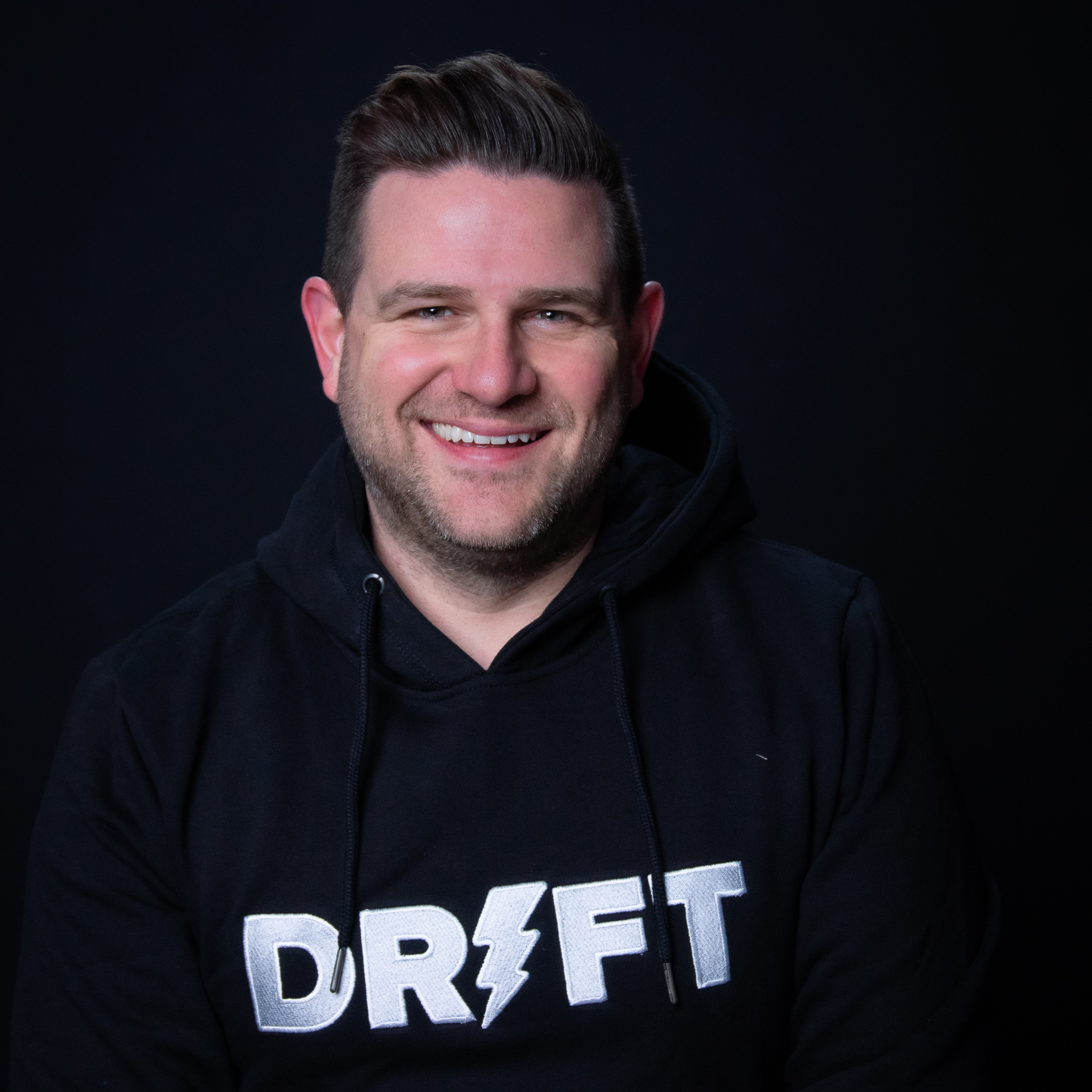
Justin Keller
Today's Guests

